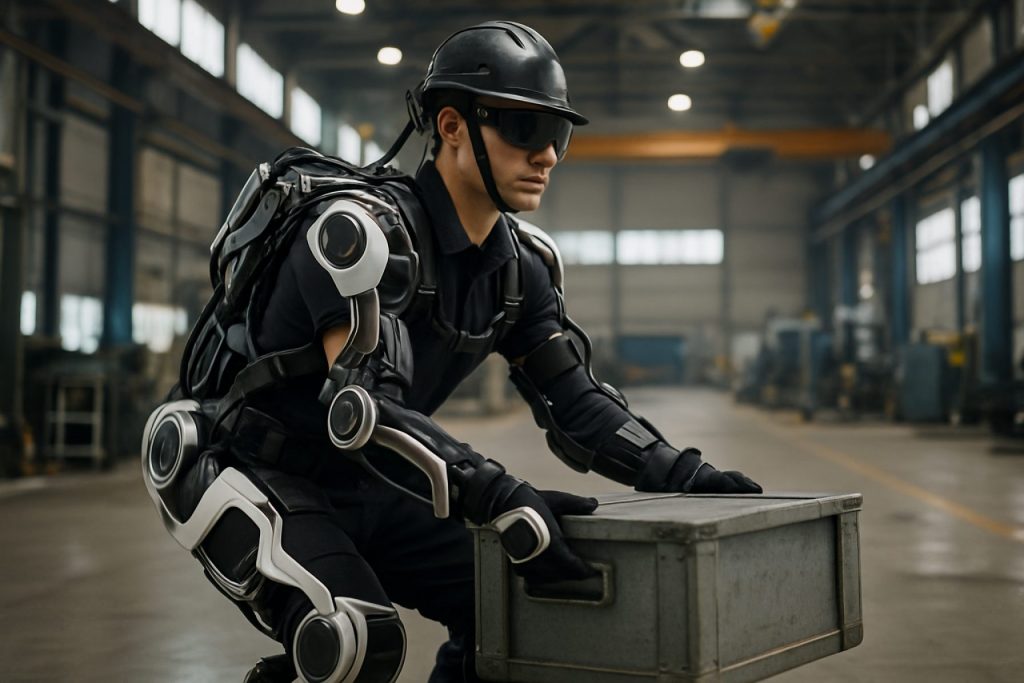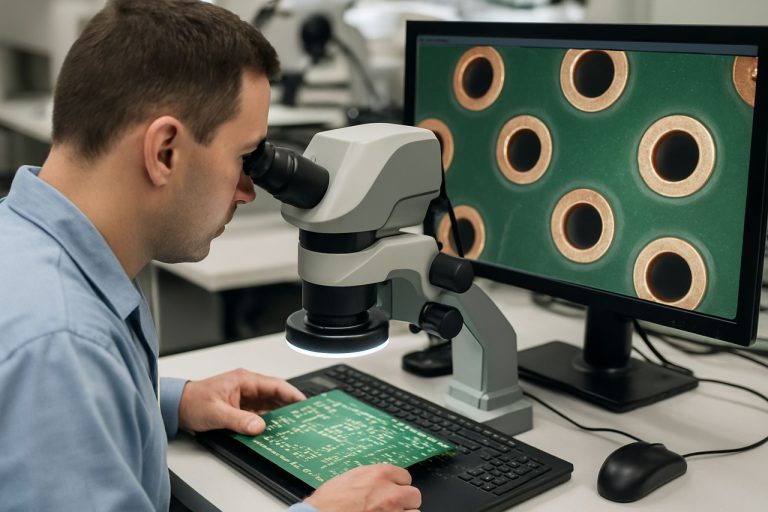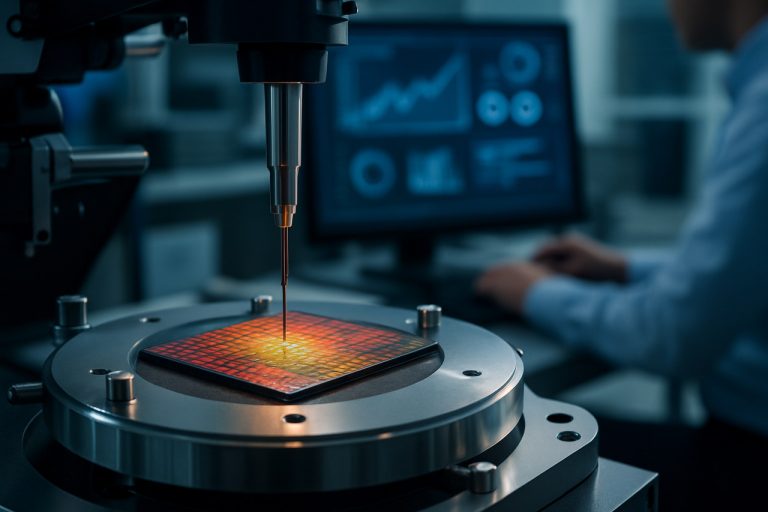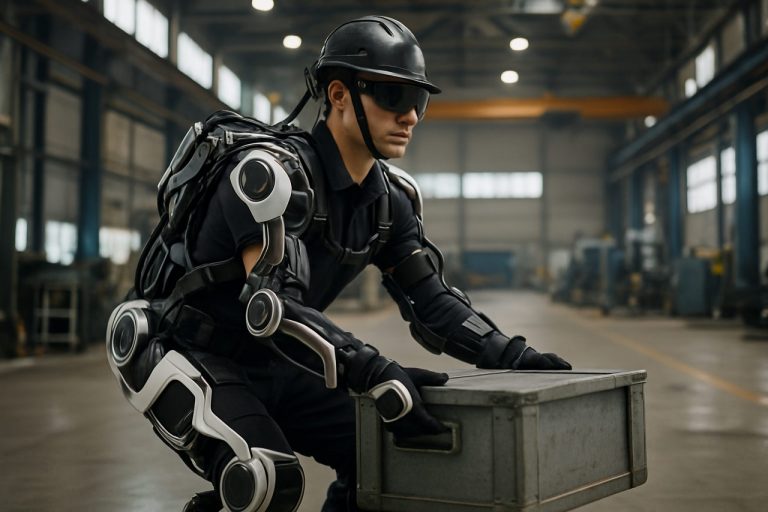
Exoskeletal Robotics Systems in 2025: Unleashing the Next Wave of Human-Machine Synergy. Explore How Advanced Exoskeletons Are Transforming Healthcare, Industry, and Mobility for the Decade Ahead.
- Executive Summary: Key Trends and Market Drivers in 2025
- Global Market Forecasts and Growth Projections Through 2030
- Technological Innovations: Materials, Sensors, and AI Integration
- Leading Manufacturers and Industry Collaborations (e.g., suitx.com, eksoBionics.com, rewalk.com)
- Healthcare Applications: Rehabilitation, Mobility, and Patient Outcomes
- Industrial and Military Use Cases: Enhancing Strength, Safety, and Productivity
- Regulatory Landscape and Standards (e.g., ieee.org, asme.org)
- Investment, Funding, and M&A Activity in Exoskeletal Robotics
- Challenges: Cost, Adoption Barriers, and Ethical Considerations
- Future Outlook: Emerging Opportunities and Next-Generation Exoskeletons
- Sources & References
Executive Summary: Key Trends and Market Drivers in 2025
Exoskeletal robotics systems are poised for significant growth and transformation in 2025, driven by technological advancements, expanding applications, and increasing investment from both public and private sectors. These wearable robotic devices, designed to augment human strength, endurance, and mobility, are gaining traction across healthcare, industrial, military, and consumer markets.
A key trend in 2025 is the rapid integration of artificial intelligence and advanced sensor technologies, enabling exoskeletons to deliver more adaptive, user-specific assistance. Companies such as SuitX (now part of Ottobock), CYBERDYNE Inc., and ReWalk Robotics are at the forefront, offering systems that support rehabilitation for individuals with mobility impairments and enhance worker safety and productivity in physically demanding environments.
In the healthcare sector, exoskeletons are increasingly used for neurorehabilitation and mobility restoration. For example, Ekso Bionics has reported growing adoption of its EksoNR exoskeleton in rehabilitation clinics, with clinical studies demonstrating improved patient outcomes in stroke and spinal cord injury recovery. The U.S. Department of Veterans Affairs continues to expand its use of exoskeletons for veterans, reflecting broader institutional support for these technologies.
Industrial applications are also expanding, with exoskeletons being deployed to reduce workplace injuries and fatigue. Ottobock and Sarcos Technology and Robotics Corporation are developing powered and passive exoskeletons for logistics, manufacturing, and construction sectors. These systems are designed to assist with lifting, carrying, and repetitive tasks, addressing labor shortages and supporting aging workforces.
Military and defense agencies are investing in exoskeletal robotics to enhance soldier endurance and reduce injury risk. Programs in the U.S., Europe, and Asia are collaborating with industry leaders to develop next-generation exoskeletons for load carriage and mobility support, with field trials and pilot deployments expected to increase through 2025.
Looking ahead, the exoskeletal robotics market is expected to benefit from regulatory approvals, cost reductions, and greater user acceptance. As exoskeletons become lighter, more affordable, and easier to use, adoption is projected to accelerate across sectors. Strategic partnerships between manufacturers, healthcare providers, and industrial firms will further drive innovation and market penetration, positioning exoskeletal robotics as a transformative technology in the coming years.
Global Market Forecasts and Growth Projections Through 2030
The global market for exoskeletal robotics systems is poised for significant expansion through 2030, driven by advances in wearable robotics, increased demand for rehabilitation solutions, and the growing adoption of assistive technologies in industrial and defense sectors. As of 2025, the sector is characterized by a diverse range of applications, including medical rehabilitation, workplace injury prevention, military augmentation, and mobility assistance for the elderly and disabled.
Key industry players are investing heavily in research and development to enhance the functionality, comfort, and affordability of exoskeletons. ReWalk Robotics, a pioneer in medical exoskeletons, continues to expand its product portfolio for spinal cord injury and stroke rehabilitation. Ekso Bionics is advancing both clinical and industrial exoskeletons, with its EksoNR and Ekso EVO systems being adopted in rehabilitation centers and manufacturing facilities worldwide. CYBERDYNE Inc. from Japan is notable for its HAL (Hybrid Assistive Limb) exoskeleton, which is used in medical and care settings, and is expanding its reach in Asia and Europe.
In the industrial sector, companies such as SuitX (now part of Ottobock) and Sarcos Technology and Robotics Corporation are developing exoskeletons aimed at reducing worker fatigue and injury in logistics, construction, and manufacturing. Lockheed Martin is also active in the defense segment, with its FORTIS exoskeleton designed to enhance soldier endurance and load-carrying capacity.
Market forecasts through 2030 indicate a compound annual growth rate (CAGR) in the high teens, with the global exoskeleton market expected to reach several billion USD by the end of the decade. Growth is particularly robust in North America, Europe, and East Asia, where supportive regulatory environments and aging populations are accelerating adoption. The medical segment is projected to remain the largest, but industrial and defense applications are expected to gain share as exoskeletons become more cost-effective and versatile.
Looking ahead, the next few years will likely see further integration of artificial intelligence, improved battery technologies, and lighter materials, making exoskeletal robotics systems more accessible and effective. Strategic partnerships between technology developers, healthcare providers, and industrial firms are anticipated to drive commercialization and scale. As regulatory approvals expand and reimbursement pathways improve, exoskeletal robotics systems are set to become a mainstream solution for mobility, rehabilitation, and workplace safety worldwide.
Technological Innovations: Materials, Sensors, and AI Integration
Exoskeletal robotics systems are undergoing rapid technological transformation, driven by advances in materials science, sensor technology, and artificial intelligence (AI) integration. As of 2025, these innovations are enabling exoskeletons to become lighter, more adaptive, and increasingly capable of supporting both medical rehabilitation and industrial applications.
Material innovation is a cornerstone of recent progress. The shift from traditional metals to advanced composites and lightweight alloys has significantly reduced the weight of exoskeletons, improving user comfort and endurance. Companies such as SUITX and CYBERDYNE are incorporating carbon fiber and high-strength polymers into their designs, resulting in devices that are both robust and ergonomic. These materials also enhance the durability and flexibility of exoskeletons, making them suitable for extended use in demanding environments.
Sensor technology has also seen substantial advancements. Modern exoskeletons are equipped with a suite of sensors—including inertial measurement units (IMUs), force sensors, and electromyography (EMG) sensors—that provide real-time feedback on user movement and intent. Ottobock and ReWalk Robotics have integrated sophisticated sensor arrays into their systems, enabling precise motion tracking and adaptive assistance. These sensors not only improve safety by detecting abnormal gait or excessive strain but also facilitate personalized rehabilitation protocols.
AI integration is rapidly transforming the capabilities of exoskeletal robotics. Machine learning algorithms analyze sensor data to predict user intentions and optimize assistance in real time. For example, Sarcos Technology and Robotics Corporation is developing AI-driven exoskeletons that dynamically adjust support based on the wearer’s activity and fatigue levels. Similarly, Hocoma leverages AI to tailor rehabilitation exercises, enhancing patient outcomes through adaptive feedback loops.
Looking ahead, the convergence of these technologies is expected to yield exoskeletons that are not only more effective but also more accessible. The integration of cloud connectivity and edge computing will enable remote monitoring and updates, while ongoing miniaturization of components will further reduce device size and weight. As regulatory pathways become clearer and costs decrease, exoskeletal robotics systems are poised for broader adoption in healthcare, manufacturing, and logistics over the next several years.
Leading Manufacturers and Industry Collaborations (e.g., suitx.com, eksoBionics.com, rewalk.com)
The exoskeletal robotics systems sector is experiencing rapid growth and innovation, driven by a combination of established manufacturers, emerging startups, and strategic industry collaborations. As of 2025, several companies are at the forefront of developing and commercializing exoskeleton technologies for medical rehabilitation, industrial support, and military applications.
One of the most prominent players is Ekso Bionics, a California-based pioneer in wearable exoskeletons. Ekso Bionics has developed both medical and industrial exoskeletons, such as the EksoNR for neurorehabilitation and EksoVest for upper body support in industrial settings. The company has established partnerships with leading rehabilitation centers and industrial firms to expand the adoption of its devices globally.
Another key manufacturer is ReWalk Robotics, headquartered in Israel and the United States. ReWalk specializes in exoskeletons designed to assist individuals with lower limb disabilities, particularly those with spinal cord injuries. Its flagship product, the ReWalk Personal 6.0, is FDA-cleared for personal and clinical use, and the company continues to collaborate with healthcare providers to enhance device accessibility and reimbursement pathways.
Emerging innovators such as SuitX (now part of Ottobock) have contributed significantly to the field. SuitX developed modular exoskeletons for both medical and industrial applications, including the Phoenix and MAX systems. The acquisition by Ottobock, a global leader in prosthetics and orthotics, has enabled further integration of exoskeletal robotics into comprehensive mobility solutions.
In Europe, Ottobock itself is expanding its exoskeleton portfolio, leveraging its expertise in orthopedics to develop solutions for workplace ergonomics and rehabilitation. The company’s Paexo series targets industrial users, aiming to reduce musculoskeletal strain and workplace injuries.
Industry collaborations are also shaping the landscape. For example, partnerships between exoskeleton manufacturers and automotive or aerospace companies are driving the adoption of wearable robotics in assembly lines, where worker safety and productivity are paramount. Additionally, collaborations with research institutions and hospitals are accelerating clinical validation and regulatory approvals for medical exoskeletons.
Looking ahead, the next few years are expected to see increased convergence between robotics, artificial intelligence, and sensor technologies, further enhancing the functionality and adaptability of exoskeletal systems. As regulatory frameworks mature and reimbursement models evolve, broader adoption across healthcare and industry is anticipated, with leading manufacturers and their partners playing a pivotal role in shaping the future of human augmentation.
Healthcare Applications: Rehabilitation, Mobility, and Patient Outcomes
Exoskeletal robotics systems are rapidly transforming healthcare, particularly in rehabilitation, mobility assistance, and the enhancement of patient outcomes. As of 2025, these wearable robotic devices are increasingly integrated into clinical practice, driven by technological advancements, growing clinical evidence, and expanding regulatory approvals.
In rehabilitation, exoskeletons are now widely used to support gait training for patients recovering from stroke, spinal cord injuries, or neurological disorders. Devices such as the Ekso Bionics EksoNR and ReWalk Robotics ReWalk Personal 6.0 are designed to facilitate repetitive, task-specific movement, which is critical for neuroplasticity and functional recovery. Clinical studies and hospital deployments have demonstrated that exoskeleton-assisted therapy can lead to improved walking speed, endurance, and independence compared to conventional therapy alone. In 2024 and 2025, more rehabilitation centers in North America, Europe, and Asia are adopting these systems, supported by positive patient outcomes and increasing insurance coverage.
For mobility assistance, exoskeletal robotics are providing new levels of independence for individuals with lower limb paralysis or severe mobility impairments. The CYBERDYNE Inc. HAL (Hybrid Assistive Limb) exoskeleton, for example, uses bioelectric signals to assist voluntary movement, enabling users to stand, walk, and perform daily activities. These systems are being deployed not only in hospitals but also in community and home settings, reflecting a shift toward personalized, long-term mobility solutions. The trend is supported by ongoing miniaturization, improved battery life, and enhanced user interfaces, making exoskeletons more practical for everyday use.
Patient outcomes are a central focus of exoskeletal robotics development. Recent data from clinical trials and real-world deployments indicate that exoskeleton use can reduce secondary complications such as muscle atrophy, pressure ulcers, and bone density loss in immobile patients. Furthermore, psychological benefits—including increased motivation, social participation, and quality of life—are increasingly recognized as key advantages. Companies like Ottobock are expanding their exoskeleton portfolios to address both clinical and workplace applications, further broadening the impact on patient populations.
Looking ahead to the next few years, the outlook for exoskeletal robotics in healthcare is highly positive. Ongoing research, combined with artificial intelligence integration and remote monitoring capabilities, is expected to further personalize therapy and improve outcomes. As regulatory pathways become clearer and reimbursement models evolve, adoption rates are projected to accelerate, making exoskeletal robotics a cornerstone of modern rehabilitation and mobility care.
Industrial and Military Use Cases: Enhancing Strength, Safety, and Productivity
Exoskeletal robotics systems are rapidly advancing in both industrial and military sectors, with 2025 marking a pivotal year for their deployment and integration. These wearable robotic devices, designed to augment human strength, endurance, and safety, are increasingly being adopted to address labor shortages, reduce workplace injuries, and enhance operational efficiency.
In industrial settings, exoskeletons are being utilized to assist workers in physically demanding tasks such as heavy lifting, repetitive motion, and overhead work. Companies like SuitX (now part of Ottobock), Sarcos Technology and Robotics Corporation, and Panasonic Corporation have developed powered and passive exoskeletons tailored for manufacturing, logistics, and construction environments. For example, Sarcos Technology and Robotics Corporation has been piloting its Guardian XO full-body, battery-powered exoskeleton, which enables users to lift up to 90 kg repeatedly without strain, aiming to reduce musculoskeletal injuries and improve productivity. Similarly, Panasonic Corporation offers the Atoun Model Y, a wearable assist suit that supports the lower back during lifting, already in use in warehouses and factories across Asia.
The military sector is also investing heavily in exoskeletal robotics to enhance soldier performance and reduce fatigue. The U.S. Department of Defense has collaborated with companies such as Lockheed Martin Corporation to develop the ONYX exoskeleton, which provides knee and leg support to soldiers carrying heavy loads, improving mobility and endurance during extended missions. These systems are undergoing field trials and are expected to see broader deployment in the coming years, with a focus on modularity, energy efficiency, and integration with other wearable technologies.
Data from ongoing pilot programs indicate significant reductions in worker fatigue and injury rates, with some industrial users reporting up to a 60% decrease in musculoskeletal complaints after exoskeleton adoption. As battery technology, lightweight materials, and sensor integration continue to improve, the next few years are expected to bring more compact, affordable, and intelligent exoskeletal systems to market. Industry analysts anticipate that by 2027, exoskeletons will become standard equipment in high-risk industrial and military applications, fundamentally transforming how physically demanding tasks are performed.
Regulatory Landscape and Standards (e.g., ieee.org, asme.org)
The regulatory landscape and standards for exoskeletal robotics systems are rapidly evolving as these technologies transition from research and pilot projects to broader clinical, industrial, and consumer applications. In 2025, the focus is on harmonizing safety, performance, and interoperability requirements to ensure user protection and facilitate market adoption.
Key international standards bodies, such as the IEEE and the ASME, are at the forefront of developing guidelines specific to exoskeletons. The IEEE has published the IEEE 802.1AS standard for time synchronization in robotics and is actively working on frameworks for human-robot interaction, safety, and ethical considerations. Meanwhile, ASME’s Robotics Public Safety Committee is contributing to the development of performance and safety standards for wearable robotics, focusing on both medical and industrial exoskeletons.
In the medical sector, exoskeletal devices are classified as medical devices in many jurisdictions, requiring compliance with regulatory frameworks such as the U.S. Food and Drug Administration (FDA) 510(k) process and the European Union’s Medical Device Regulation (MDR). Leading manufacturers like Ekso Bionics and ReWalk Robotics have obtained FDA clearances for their lower-limb exoskeletons, setting precedents for clinical safety and efficacy. These approvals typically mandate rigorous clinical trials, post-market surveillance, and adherence to ISO standards such as ISO 13482:2014, which addresses safety requirements for personal care robots, including exoskeletons.
For industrial exoskeletons, regulatory oversight is less mature but gaining momentum. Organizations such as the Occupational Safety and Health Administration (OSHA) in the U.S. are monitoring the integration of exoskeletons in workplaces, with a focus on ergonomics, injury prevention, and worker safety. Industry consortia, including the Exoskeleton Report and the International Exoskeleton Association, are collaborating with standards bodies to develop best practices and certification pathways.
Looking ahead, the next few years are expected to bring greater alignment between international standards and national regulations, particularly as exoskeletons become more prevalent in rehabilitation, eldercare, logistics, and manufacturing. The ongoing work by IEEE and ASME, combined with regulatory engagement from agencies like the FDA and OSHA, will be critical in shaping a robust, globally recognized framework for exoskeletal robotics systems. This will not only enhance user safety but also accelerate innovation and adoption across sectors.
Investment, Funding, and M&A Activity in Exoskeletal Robotics
The exoskeletal robotics sector has experienced a surge in investment, funding, and merger and acquisition (M&A) activity as the technology matures and its applications expand across healthcare, industrial, and defense markets. In 2025, the global landscape is characterized by both established players and innovative startups attracting significant capital to accelerate product development, regulatory approvals, and market expansion.
One of the most prominent companies in the field, Ekso Bionics Holdings, Inc., continues to secure funding to support its rehabilitation and industrial exoskeletons. The company has a history of raising capital through public offerings and strategic partnerships, and in recent years has focused on expanding its footprint in North America, Europe, and Asia. Similarly, ReWalk Robotics Ltd. has maintained its position as a key player in the medical exoskeleton market, leveraging both private and public investment to advance its wearable robotic solutions for individuals with lower limb disabilities.
In Asia, CYBERDYNE Inc. remains a leader in the development and commercialization of exoskeletons for medical and industrial use. The company has benefited from government-backed initiatives and private investment, enabling it to expand its product portfolio and global reach. Meanwhile, Hocoma AG, part of the DIH Group, continues to attract investment for its rehabilitation robotics, including exoskeletal systems, as it strengthens its presence in clinical settings worldwide.
The sector has also witnessed notable M&A activity. Larger medical device and industrial automation companies are increasingly acquiring or partnering with exoskeleton startups to integrate advanced robotics into their offerings. This trend is exemplified by collaborations between exoskeleton developers and established healthcare technology firms, as well as acquisitions aimed at consolidating intellectual property and accelerating commercialization.
Looking ahead to the next few years, the outlook for investment and M&A in exoskeletal robotics remains robust. The growing demand for assistive technologies in aging populations, the need for workplace injury reduction, and advancements in materials and AI-driven control systems are expected to drive further capital inflows. Strategic investors, including major medical device manufacturers and industrial conglomerates, are likely to continue seeking opportunities to enter or expand within the exoskeleton market, fostering innovation and competition.
Overall, the exoskeletal robotics sector in 2025 is marked by dynamic investment activity, with both established and emerging companies leveraging funding and strategic transactions to accelerate growth and broaden the impact of wearable robotic technologies.
Challenges: Cost, Adoption Barriers, and Ethical Considerations
Exoskeletal robotics systems, while promising transformative benefits across healthcare, industry, and defense, face significant challenges in cost, adoption, and ethical considerations as of 2025 and looking ahead. The high cost of development and deployment remains a primary barrier. Advanced exoskeletons, particularly those designed for medical rehabilitation or industrial augmentation, often incorporate sophisticated sensors, actuators, and AI-driven control systems, driving up unit prices. For example, leading manufacturers such as Ekso Bionics and ReWalk Robotics offer medical exoskeletons that can cost tens of thousands of dollars per unit, limiting accessibility for smaller clinics and individual users.
Adoption barriers are further compounded by the need for specialized training and integration into existing workflows. In industrial settings, companies like SuitX (now part of Ottobock) and Sarcos Technology and Robotics Corporation have piloted exoskeletons to reduce worker fatigue and injury. However, widespread deployment is slowed by concerns over return on investment, device reliability, and the need for ergonomic customization to fit diverse body types and tasks. Additionally, regulatory approval processes, especially in the medical sector, can delay market entry and increase costs.
Ethical considerations are increasingly prominent as exoskeletal systems become more capable and autonomous. Issues include data privacy—since many exoskeletons collect sensitive biomechanical and health data—and the potential for workplace surveillance. There are also concerns about exacerbating inequalities if only certain workers or patients have access to these technologies. In military applications, companies such as Lockheed Martin have developed exoskeleton prototypes for soldier augmentation, raising questions about the implications for human enhancement and the potential for coercion or overreliance on technology in high-risk environments.
Looking forward, industry stakeholders are working to address these challenges. Efforts include modular designs to reduce costs, open standards for interoperability, and collaborative initiatives with regulatory bodies to streamline approvals. Ethical frameworks are being developed in partnership with organizations such as the International Organization for Standardization (ISO) to guide responsible innovation. Despite these efforts, the pace of adoption in 2025 and the next few years will likely depend on continued cost reductions, demonstrable safety and efficacy, and robust engagement with ethical and societal concerns.
Future Outlook: Emerging Opportunities and Next-Generation Exoskeletons
The exoskeletal robotics systems sector is poised for significant transformation in 2025 and the years immediately following, driven by rapid technological advancements, expanding application domains, and increasing investment from both public and private sectors. The convergence of lightweight materials, advanced sensors, and artificial intelligence is enabling the development of next-generation exoskeletons that are more ergonomic, adaptive, and accessible than ever before.
Key industry players are accelerating innovation to address both medical and industrial needs. ReWalk Robotics continues to refine its wearable exoskeletons for individuals with lower limb disabilities, focusing on improved mobility, user comfort, and integration with smart devices. Meanwhile, Ekso Bionics is expanding its product line to serve not only rehabilitation clinics but also industrial workplaces, where exoskeletons are being deployed to reduce worker fatigue and prevent musculoskeletal injuries.
In the industrial sector, companies such as Sarcos Technology and Robotics Corporation are advancing powered exoskeletons designed for heavy lifting and repetitive tasks, with pilot programs underway in logistics, construction, and manufacturing. These systems are expected to become more prevalent as organizations seek to enhance worker safety and productivity, particularly in regions facing labor shortages and aging workforces.
Emerging opportunities are also evident in the defense and emergency response sectors. Lockheed Martin is developing exoskeletons for military applications, aiming to augment soldier endurance and load-carrying capacity. Such systems are anticipated to transition from prototype to field deployment within the next few years, with potential spillover benefits for civilian disaster response and hazardous environment operations.
Looking ahead, the integration of machine learning algorithms and cloud connectivity is expected to enable exoskeletons that can adapt in real time to user intent and environmental conditions. This will open new possibilities for personalized rehabilitation, remote monitoring, and predictive maintenance. Additionally, collaborations between exoskeleton manufacturers and healthcare providers are likely to accelerate, fostering the development of devices tailored to specific patient populations and clinical needs.
As regulatory frameworks evolve and costs decrease, the adoption of exoskeletal robotics systems is projected to expand globally, with Asia-Pacific and Europe emerging as key growth markets alongside North America. The next few years will be pivotal in shaping the landscape of exoskeletal robotics, with a focus on scalability, interoperability, and user-centric design.
Sources & References
- SuitX
- CYBERDYNE Inc.
- ReWalk Robotics
- Ottobock
- Sarcos Technology and Robotics Corporation
- Lockheed Martin
- Hocoma
- Ekso Bionics
- SuitX
- Ottobock
- Panasonic Corporation
- Lockheed Martin Corporation
- IEEE
- ASME
- Exoskeleton Report
- International Exoskeleton Association



